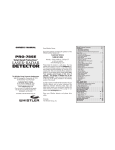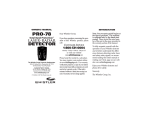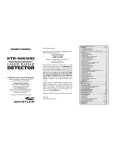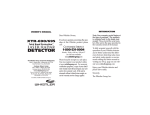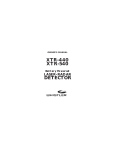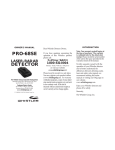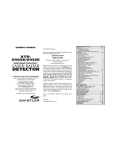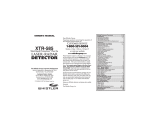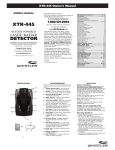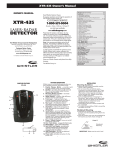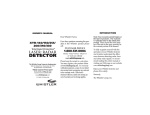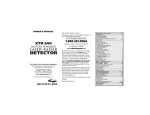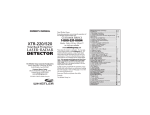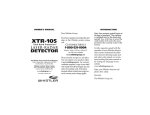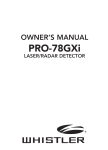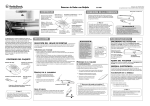Download Whistler CR85 User's Manual
Transcript
WHISTLER FEATURES OWNER’S MANUAL FEATURE DESCRIPTIONS 1. CR85 HIGH Performance LASER-RADAR DETECTOR 13 1 14 6 2 9 11 10 7 8 3 12 4 Features •RadarSignatureID(RSID) •LaserSignatureID(LSID) •3FilterModes •KaMaxMode •TotalBandProtection™ •OLEDTextDisplay •DetectsPOP™ Mode •360°MaxxCoverage •RealVoice® •3CityModes/HighwayMode OPERATION Power On Self Test & Volume To turn the unit ON or OFF, gently press the center of the Power/Volume button into the side of the unit. Each time your Whistler detector is turned on, an automatic self-test sequence confirms that the speaker and visual displays are functional. Audio Level Adjustment Tochangetheaudiolevel: • Move Power/Volume button back to increase audio level. • Move Power/Volume button forward to decrease audio level. As audio level is adjusted,beepsareprovidedandthedisplay indicates volume level. Auto Quiet Mode Auto Quiet mode reduces the selected audio leveltolevel(1)approximately5secondsafter a radar or safety warning system™ signal is detected. The alert for any new signal within 20secondswillresumeatlevel(1).AutoQuiet mode does not affect laser alerts. • PressQuiet(beforeasignalisdetected)to engage Auto Quiet mode. •OncetheAutoQuietmodeisengaged,you may cancel the audio alarm by pressing Quiet. •PressQuiet(whentheunitisnotalarming)to cancel Auto Quiet mode. Quiet Mode Quiet mode cancels audio during an alert and any new alert within20seconds.After20 seconds of no radar signal detected, the audio alerts are restored. •PressQuiettocanceltheaudio. •Press Quiet a second time during an alert to restore the standard audio alert pattern. •Quiet/Auto Quiet Mode •Dim/DarkMode •AutoDim •StayAlert™ •SettingSaver •SelectableVehicleBatterySaver™ •SafetyWarningSystem™ •AlertPriority •AlertPeriscopes •TrafficFlowSignalRejection OPERATION City/City 1/City 2 Mode Whistler’sThreeStageCityModeisdesigned to reduce the annoyance of automatic door openers, intrusion alarms and other devices which share frequencies with police radar. Generally, X band is used for these devices. •PressCitybuttontocancelHighwayMode and engage City Mode. •PressCitybuttonagaintoenterCity1Mode. •PressCitybuttonagaintoenterCity2Mode. •PressCitybuttonafourthtimetocancelCity2 Mode and returns the unit to Highway Mode. In City Mode, weak speed/safety warning system™ signals give an initial alarm of two beeps, and then remains quiet unless the signal becomes very strong. When the signal strength increases, two additional beeps are provided. City1andCity2Modesoperatethesameas HighwayMode,butinCity1Mode,onlythe Xbandsensitivityislowered.InCity2Mode, X-band is not detected. Caution: Sometowns/smallcitiesmaystillbe using X band radar. City Modes do not change the audio alert for laser. Highway Mode 5 Highway mode provides full audio warnings anytimeradar(X,K,Ka,SafetyWarning System™) or laser signals are detected, and is recommended for open road driving. Bracket Release Button – provides quick and easy release of the mounting bracket. 2. Speaker – provides distinct audio warnings for X, K, Ka band radar, safety warning system, and laser. 3. Mounting Bracket Location – slot holds mounting bracket firmly. 4. Radar Antenna – compact, high-efficiency antenna receives radar signals. 5. Front Laser – high gain optical lens provides increased sensitivity and field of view for leading-edge laser detection. 6. Rear Laser – an integrated optical waveguide provides superior detection of laser signals transmitted from behind. 7. City Button - reduces the annoyance of false alerts typically encountered in urban driving areas. 8. Quiet Button - pressingQUIETbeforea signal is detected engages Auto Quiet Mode which automatically reduces the audio level after the initial warning to a low audio level setting. PressingQUIETduringaradar/laserencounter silences audio alerts, while allowing visual alerts to keep you informed. 9. Power / Volume Control – gently press this button in to turn the unit on/off. Move back or forwardtoadjusttheaudiolevel. 10. Dim / Dark - engages Dim/Dark modes. 11. Menu Button -entersOptionSelectMode. 12. Text Display – provides distinct visual confirmation of signals detected, signal strength, and indicates engaged modes of operation. 13. Alert Periscopes - provide an additional attention getting visual alert. 14. Power Jack – Provides connection for the power cord. INSTALLATION Mounting Guidelines • Mount the unit as low as possible near the center of the windshield. • Do not mount the unit behind wipers, ornaments, mirrored sunscreens, etc. These obstructions have metal surfaces which can affect radar and laser signals and reduce criticalwarningtime.(Regulartintedglass does not affect reception). • SomewindshieldshaveanInstaclear™ or Electriclear™ type coating, which affect radar signals. Consult your dealer or the owner’s manual supplied with your vehicle to determine if your windshield has this coating. • Avoid placing the unit in direct contact with the windshield. • To reduce the possibility of theft, conceal the unit when not in use. Whistler’s Alert Periscopes provide an added attention getting visual alert. The two extra LEDs flash on and off when the unit alarms to provide a unique visual alert. This alert can be programmed, throughtheOptionSelectModeto:1.flashforall alarms,2.remainon, or 3. turn LEDs off completely. Dim/Dark Mode Dim/Dark Mode reduces the illumination of the display. • Press the Dark button to reduce illumination to a Dim setting. • Press the Dark button a second time engages Dark Mode. The display illumination is further reduced. Windshield Mounting IMPORTANT:Makesuretheunitislevel Windshield Mounting • Install the two suction cups and rubber bumper onto the bracket by fitting them into their holes. • Press the suction cups onto the windshield at the location you have chosen. OPERATION Integrated Real Voice® ® Whenselected,RealVoice will be used to articulatethefollowing: 1. BandIdentification 2. SafetyWarningSystemmessages 3. FeatureSelection Note: In certain cases, the voice message does not replicate the text message. Teach/Tutorial Mode Provides simulated alerts for each type of signal. • Plug the small end of the power cord into the unit’spowerjack. • Plug the large end into the vehicle’s cigarette lighter socket. Note: Cord fits tightly into detector. When installing the cord, expect some resistance. The“U”typeconnectormustbesecuredto a metal surface that is electrically connected to the battery ground (negative) terminal.The spade type connector can connect to either live 12voltsorswitched12voltsatyourfusepanel accessory port. If no port is available, cut off the spadeterminal,expose1/4to1/2inchofwire, andspliceintoasourceof12voltpower. Fuse Replacement - Hardwire Kit The inline fuse holder on the power cable is equippedwithareplaceable2amp,3AGfuse located inside the fuse holder. To replace the fuse, carefully twist the holder to open it to gain access to the fuse. Fuse Replacement The lighter socket plug is equipped with a replaceable2amp,3AGfuselocatedbehind the silver tip. To replace the fuse, carefully unscrew the tip of the plug. OPERATION X/K and Ka Filter Modes There are times when a radar detector in another vehicle, can emit a frequency which can cause your detector to falsely alert. These Filter Modes allow you to select the level needed for your area to minimize the occurrences of these false alerts. X/K and Ka Filter Mode factory default settings should provide adequate filtering for most conditions. If you experience excessive alerts due to radar detectors in other vehicles, increase theFilterlevelforthebandreceived.SeeOption SelectionModetochangethefiltersettings. Ka Max Mode •DisplayShows: Ka Max Mode provides enhanced Ka sensitivity increased protection. This mode can be selected with orwithoutRSID.SeeOptionSelectModeforchanging Ka options. •PressDarkbuttontoexit. Traffic Flow Signal Rejection (TFSR) •PressCityandQuietbuttonssimultaneously Setting Saver • Press the Dark button a third time to restore full illumination to the display. Feature Engaged Confirmation TheVehicleBatterySaverModeautomaticallyshuts off your detector within 3 hours. The timer is reset if the detector is turned off, unplugged or any button is pressed before the timer has expired. The detector will alert you with an audible and visual warning before it shuts off. During this warning, you can momentarily reset the timer by pressing any button. If the unit has automatically turned off, press the Power button to turn the unit back on. Referto“Option SelectMode”forinstructionsforchangingthe battery saver mode options. • If necessary, the unit may be leveled by bending the windshield bracket. Press the bracket release button and remove the detector before bending. Installing the Hardwire Kit Rubber Bumper Dim or Dark Mode can be engaged during an alert. In Dark Mode, the display goes dark for aslongasasignalisbeingdetectedandfor20 seconds after, then the display returns to the dimmer setting. Selectable Vehicle Battery Saver Mode INSTALLATION IMPORTANT: Unscrewslowly.Thetipcontains a spring which may fly out when disassembling. Insert the new fuse with the spring and screw on the tip. With use, the screw cap on the plug may loosen.Retightenitoccasionally. Power Cord Connection OPERATION Alert Periscopes INSTALLATION Important: Somenewercarshaveaplasticsafety coating on the inside of the windshield. The windshield bracket may leave permanent marks on this type of surface. To find out if your vehicle has this type of windshield, check the vehicle’s owner’s manual or ask your dealer. We recommend that you do not leave the suction cup bracket on the window in direct sunlight. If the detector is removed, this may cause blistering of the dash in some vehicles. • Slidethedetectorontothebracketuntilitlocksinto place. SettingSaverstoresyourpersonalizedsettings so that when the detector is turned off and then on again, you do not have to re-enter them. Each time a button is pressed, one beep confirms feature “on”, two beeps confirm feature “off”. Auto Dim The Auto Dim feature automatically switches the illumination of the text display between the bright and dim settings according to varying light conditions so that the text display will always be easy to read. To manually override the auto dim feature, use the dark button on theunit.EnterOptionSelectModetoturnoff the auto dim feature. Recently,manynewproductsoperateonXorKband causingnuisancealertstoradardetectors.Someof theseareradarbasedTrafficMonitoringSystems mounted to poles alongside the highway and others areKBandLaneChangeAssistantsandBlindSpot Detectors found on some automobiles. When turned on in option mode, helps eliminate excessive alerts from erroneous X and K-band sources. Traffic flow monitoring systems are getting more common. Many of these systems generate radar signals to measure the flow of traffic across multiple lanes. Most detectors will alert youtoitunnecessarily.Thisrejectionfeatureexamines the incoming signal and will aid in reducing the alerts to such sources. We suggest you turn TFSR on if you are experiencing excessive X or K band false alerts every half mile or so along stretches of roadway that contain these traffic flow sensors. Option Select Mode PresstheMenubuttontoenterOptionSelectMode. Each press of the Menu button changes to the next selectable feature.The Dark (D) button and the Quiet (Q) button turns the feature ON/OFF or Blinking for example.Abuttonmustbepressedwithin20seconds orOptionSelectModewillautomaticallybeexited.(See page 13 for chart) OPERATION NOTE: Press and hold Menu button to exit Option SelectMode. Feature Display To Change: Option Shows D=Dark Q=Quiet QUIET S1: Quiet D or Q to select POWER S2: Power D or Q to select AUTO DIM ADIM:ON TONE TONE 3 TEST TEST ON X BAND X = ON D = ON Q = OFF D or Q to select LASER LSR NORM D or Q to select LASER AREA 1 LASER AREA 2 .02-.09 Y 2.6-3.2 Y D = ON Q = OFF Auto Dim On Auto Dim Off Tone 1, 2, 3 (3 Different Tone Patterns) ON = X, K, Ka Audio Tones LASER (NORM,OFF,LSID) D or Q to select Laser Area 1 ON Laser Area 1 OFF D or Q to select Laser Area 2 ON Laser Area 2 OFF Laser Area 3 ON Laser Area 3 OFF 3.8-4.2 Y D or Q to select SWS™ SWS OFF D = ON Q = OFF Turn SWS™ ON Turn SWS™ OFF VOICE® VOICE ON D = ON Q = OFF POP™ POP OFF D = ON Q = OFF Real VOICE® Engaged Real VOICE®Disengaged B SVR ON D = ON Q = OFF TFSR = ON TFSR = OFF (default) TFSR OFF LASER AREA 3 BATTERY SAVER Alert Periscopes ON (ON, OFF or Blinking) TFSR Ka Band (RSID,NORM, OFF,MAX,MAXID) D or Q to select D or Q to select Remote Control of Dim, City, Quiet Power Functions K Band ON K Band OFF KaMAXID Ka FLTR 1 LEDBLNK X Band ON X Band OFF Ka BAND Ka FILTER D or Q to select OFF = One Beep During Power Up D = ON Q = OFF XK FLTR 1 ALERT PERISCOPES D = ON Q = OFF K = ON (cont’d) D or Q to select XK FILTER Remote Control of Dim, City, Quiet Power Functions D = ON Q = OFF K BAND OPERATION Option Select Mode POP ON POP OFF Battery Saver ON Battery Saver OFF Filter 1, Filter 2, Filter 3 Filter 1, Filter 2, Filter 3 Stay Alert Feature TheStayAlertFeatureisdesignedtotestadriver’s alertness.Toengage(whentheunitisnotalarming): • PressandholdtheCitybuttonfor approximately2seconds.Releasethebutton during or immediately after the alert is given. DISPLAYSHOWS: Within 30-60 seconds, two beeps are sounded; to show alertness, the driver must press either the City, Menu, or Quiet buttons within 3-5 seconds. If a button is pressed within 3-5 seconds, the cycle is repeated. If a button is not pressed within 3-5 seconds, an alarm sounds. DISPLAYSHOWS: • PresstheDarkbuttontoexittheStayAlert feature. WARNING!!! StayAlertisNOTintendedasa substitute for adequate rest. You should NOT operate a vehicle if you are drowsy. During extended periods of vehicle operation, you should take frequent breaks. ImproperrelianceontheStayAlertfeaturemayresultin vehicledamage,personalinjuryordeath. NEVER OPERATE A VEHICLE IF YOU ARE DROWSY! OPERATION OPERATION Alert Priority When two or more signals are received at the same time, the alert priority is: 1. Laser 2. Speed Radar 3. Safety Warning System™ Example: If X band is alerting, then suddenly a laser signal is detected, the laser warning will override the X band alert. SWS™ In communities where transmitters are located, the Safety Warning System™ provides over 60 text messages. When SWS™ is detected the audio alert is geiger counter-like. Safety Warning System Text Message Example: Poor - Road - Surface. Note: Not all areas have Safety Warning System transmitters. ™ The optional INTELLICORD® power cable allows the user to remotely control Power, City, Dim, Quiet and Auto Quiet functions with the press of a button located on the power cable’s plug. All user features can be reset to factory settings. •Unplug the Power Cord from the unit. •Press and hold the Power and Quiet buttons. •Plug the Power Cord into the unit. •Wait for 2 beeps. •Release the Power and Quiet buttons. Safety Warning System™ Intellicord® Ready Reset Features Unit is now reset to the following features and settings. Default factory settings are: 1. S1: (For Intellicord®) Quiet feature 2. S2: (For Intellicord®) Power ON or OFF 3. ADIM: ON (Auto Dim ON) 4. HIGHWAY Mode 5. Dim/Dark Mode to full illumination of display. 6. Auto Quiet Mode OFF 7. SWS™ OFF 8. Vehicle Battery Saver ON 9. Full Power Up sequence 10. Default TONE 3 11. All Bands ON 12. LASER NORM 13. All Laser Windows ON 14. POP OFF 15.Voice® ON 16. LED Periscopes to BLNK 17. X/K Filter 1 18. Ka Filter 1 19. TFSR OFF OPERATION POP™ MODE ALERTS Whistler has two features that will assist the driving enthusiast to further identify threats from laser and Ka band radar guns. Ka RSID (Ka Radar Signal IDentifier) Identify the difference between the likelihood of a Ka threat vs. the likelihood of a Ka false from another source (possible radar detector). Ka RSID feature will educate you to the common Ka speed radar guns by displaying the nominal police radar frequencies of 33.8GHz / 34.0GHz / 34.3GHz / 34.7GHz / 35.5GHz. Ka alerts that do not fall into the common Ka speed radar windows will be reported only as Ka. Note: This product is not a frequency counter. The unit will categorize the received Ka signal and select the appropriate information. Treat every Ka alert with caution. LSID (Laser Signal IDentifier) Identify the Laser gun’s pulse rate or PPS (Pulses Per Second) that is transmitted by the speed laser gun. LSID may also be used to identify other forms of laser sources such as LACC (Laser Assisted Cruise Control) systems found in some high end vehicles. If the Laser PPS information displayed is due to another source such as local airports or LACC, LSID allows you to Lock Out this rate from giving you the continuous audio alert during this and any new encounter of the same rate. To Lock Out a PPS, press the Quiet button during the Laser alert. This will place an * on the screen beside the PPS rate and Lock Out this signature ID. Any new encounter with the same Laser Signature ID will provide the display information and two quick beeps. Note: Common Laser PPS rates used in the USA are 100 / 125 / 130 / 200 / 238 / 380Hz. Other Laser PPS rates used outside the USA include 600Hz. Caution: Do not lock out a PPS rate if it is close to known speed laser guns. POP Mode Alerts ™ Because POP™ Mode radar utilizes the same K or Ka band frequencies, POP™ Mode Alerts will be displayed as regular radar alerts. LASER/RADAR ALERTS Speed Radar Audio/Visual Alerts When X, K or Ka is detected, the band ID and signal strength are displayed. The audio alert is continuous and has a geiger counter-like pattern. The faster the beep, the closer or stronger the radar source. Laser Audio/Visual Alerts When a laser signal is detected the audio alert is continuous for a minimum of 3 seconds. • The Displays Shows: Pulse Protection® Pulse (or instant-on) radar is more difficult to detect than conventional radar because it remains ‘off’ until activated to measure the speed of a targeted vehicle. When a pulse type transmission is detected, your Whistler detector sounds an urgent 3-second audio warning and the display shows: After the 3-second pulse alert, the standard alert pattern continues for as long as the signal is present. It is important to respond promptly to a pulse alert, since warning time may be minimal. SPEED MONITORING Laser Tips If you are the targeted vehicle, a laser gun can often determine your speed within a few seconds after you receive an alert. In this situation, there is generally no time to safely adjust your speed. However, if you are traveling near or behind the targeted vehicle and receive an alert, response time should be sufficient. Any laser alert, regardless of duration, requires immediate action. Radar Facts A radar gun operates by transmitting radio waves at certain frequencies which reflect off objects and are picked up by the radar gun’s receiving section. When a radar beam reflects a measurable frequency off a moving target, shift occurs. The radar unit converts this shift into miles per hour to determine your vehicle’s speed. Currently, the FCC (Federal Communications Commission) permits operation of traffic radar guns at X Band (10.500 - 10.550 GHz), K Band (24.050 - 24.250 GHz), and Ka Band (33.400 36.000 GHz). TROUBLESHOOTING Your Whistler detector is expertly engineered and designed to exacting quality standards to provide you with reliable, trouble-free operation. If your unit has been correctly installed following the guidelines in this manual, but is not operating optimally, please refer to the troubleshooting guide below. PROBLEM: No display or audio. • Check fuse in plug; replace if necessary with a 2 amp, 3AG type. • Check fuse for lighter socket; replace if necessary. • Make sure lighter socket is clean. PROBLEM: Unit alarms when vehicle hits bumps. • Check for loose lighter socket; tighten and clean. • Check connections at both ends of the power cord. Substitute another cord to determine if the cord is defective. Return defective cord to the factory. PROBLEM: Audio alerts are not loud enough. • Cancel Auto Quiet Mode or City Mode. • Check audio level setting (see page 8 ). If difficulties occur which cannot be solved by information in this Troubleshooting Guide, please call Whistler Customer Service at 1-800-531-0004 or visit our F.A.Q. page at www.whistlergroup.com, before returning your unit for service. CARE AND MAINTENANCE During the summer months, avoid prolonged exposure to direct sunlight by removing your unit from the dash when your vehicle is parked for an extended period of time. Do not spray water, cleaners, or polishes directly onto the unit. The spray may penetrate through the openings and damage the unit. Also, do not use any abrasive cleaners on the unit’s exterior. ARE DETECTORS LEGAL? In Most States YES. Laser-Radar detectors are legal in every state (except Virginia and Washington, D.C., which have local regulations restricting the use of radar receivers in any vehicle) when used in automobiles or light trucks (under 10,000 lbs.). The Federal Highway Administration (FHWA) issued a regulation, effective January, 1994 which prohibits radar and laser detector use in vehicles over 10,000 lbs. Prior to the FHWA regulation, laws existed in New York restricting the use of radar detectors in trucks over 18,000 lbs. and in Illinois in trucks over 26,000 lbs. FCC INFORMATION FCC ID: HSXWH20 This device complies with part 15 of the FCC Rules. Operation is subject to the following two conditions: (1) this device may not cause harmful interference, (2) this device must accept any interference received, including interference that may cause undesired operation. Important: FCC requirements state that changes or modifications not expressly approved by Whistler could void the user’s authority to operate the equipment. POP™ Mode POP™ Mode is a feature on some radar guns operating on K and Ka bands. When the gun is in POP™ Mode and activated, a brief burst of energy, less that 1/15 of a second, is transmitted and the vehicle’s speed is quickly acquired. A detector without POP™ Mode detection capability cannot respond to this brief transmission. SPEED MONITORING Laser Facts It’s well documented that many radar guns cannot reliably provide the speed of a targeted vehicle that is traveling in a group of vehicles. In contrast, a laser gun can target a specific vehicle out of a line of traffic and determine its speed. The advantage of laser over radar in terms of target identification is the result of the laser gun’s narrow beam. A radar gun’s transmission can cover more than a four-lane highway at a distance of 1,000 feet, compared with a laser gun’s transmission which covers about 3 feet at the same distance. For best protection, keep these points in mind: •Because the vehicle’s license plate or headlights are the laser gun’s primary targets, mounting the Whistler detector on the dashboard can improve laser detection at short range. •Do not follow closely behind any vehicle you cannot see through. If you can’t see past a vehicle ahead of you, chances are your detector can’t either. •The receiving range of your laser detector will not be the same as a radar detector. Laser guns are most often used at short range. Whistler Laser-Radar detectors receive all current laser guns which operate at a laser wavelength of 905 +/- 50nm. • Ultra Lyte • LTI 20-20 • LTI TruSpeed® S • Laser Ally • Pro Laser™ I II III • Laser Atlanta® Stealth Mode SPEED MONITORING Radar Detector Detectors: VG-2, Spectre The Interceptor VG-2 orsimply VG-2, is one type of microwave receiver used by Police to detect signals radiated by the local oscillator of a radar detector. Because its purpose is to identify persons driving with radar detectors, these devices are known as a “radar detector detector” (RDD). An RDD is the primary tool used by the police to identify radar detector equipped vehicles. If caught in a state or country where detectors are illegal (see page 20), drivers risk losing their radar detector and receiving a fine. In addition, instant-on radar is almost always used in combination with an RDD, leaving unsuspecting motorists vulnerable to receive two tickets; one potential for speeding, and the other for possession of a detector. Note: The newest tool Police have to detect radar detectors is called Spectre. Spectre can detect the majority of undetectable (VG-2) laser/radar detectors on the market. It is the responsibility of the individual radar detector user to know and understand the laws in your area regarding the legality of the use of radar detectors. Note: A radar detector will only alarm if an officer is transmitting on any one of the above radar bands. WHISTLER RADAR DETECTORS Other Speed Detection Systems Several techniques other than radar or laser are used to measure vehicle speeds. When these methods are being used, no detector can provide a warning. These techniques include: • Pacing - A patrol car drives behind you and matches your driving speed. •Vascar/Aircraft - The police measure the time it takes your vehicle to travel a known distance. GPS RADAR DETECTOR



